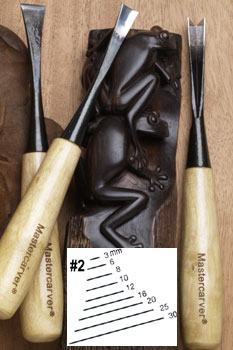I just ordered a few Warren gouge blades. You can see them on the lower left of this page:
http://www.warrencutlery.com/indexb.htm
I have one of the little gouges on the lower right, the ever popular 3/4" fish tail 4 sweep, and while it is one of my favorites, it is not just a handled version of one of the gouges. The fixed handled gouges have shorter shanks and the blade profiles available don't line up exactly. Anyway, I am not going to make a handle like those.
My first thought is to turn a handle similar to what many small to middlin' gouges and chisels have:

That have a slight flat spot for "registration" (so you hold them the same way every time after a few uses) and to be less prone to rolling. If I do that, is there any sort of magic formula for finger length to best diameter?
Other profiles you might suggest? I am mulling the idea of going a little long so I can do the two handed relief technique (rock the baby ). I also plan to leave a flat spot for occasional additional light persuasion. I harbor no illusions about making them mallet tools, but sometimes a tap is a lot easier to control.
). I also plan to leave a flat spot for occasional additional light persuasion. I harbor no illusions about making them mallet tools, but sometimes a tap is a lot easier to control.
As a point of reference, here is the "standard" handle that Warren sells:

http://www.warrencutlery.com/indexb.htm
I have one of the little gouges on the lower right, the ever popular 3/4" fish tail 4 sweep, and while it is one of my favorites, it is not just a handled version of one of the gouges. The fixed handled gouges have shorter shanks and the blade profiles available don't line up exactly. Anyway, I am not going to make a handle like those.
My first thought is to turn a handle similar to what many small to middlin' gouges and chisels have:

That have a slight flat spot for "registration" (so you hold them the same way every time after a few uses) and to be less prone to rolling. If I do that, is there any sort of magic formula for finger length to best diameter?
Other profiles you might suggest? I am mulling the idea of going a little long so I can do the two handed relief technique (rock the baby
As a point of reference, here is the "standard" handle that Warren sells:


